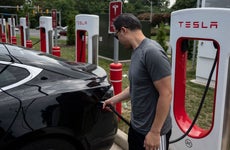Investing in Tesla stock in 2022

The Bankrate promise
At Bankrate we strive to help you make smarter financial decisions. While we adhere to strict , this post may contain references to products from our partners. Here's an explanation for .
As one of the leading innovators in electric vehicles, carmaker Tesla has generated a lot of press. It’s developed a loyal following from customers who believe in the company’s technology and often laud CEO Elon Musk with devotion. It’s one of the highest-profile Silicon Valley tech companies, and investors have enjoyed the stock’s quick run-up over the last decade, particularly during the global pandemic.
But today’s Tesla investors need to understand how the company will be impacted by increasing competition in electric vehicles from legacy carmakers such as Ford (F) and General Motors (GM), as well as what the impact will be from higher interest rates on Tesla’s lofty valuation.
Here’s what else you should know about investing in Tesla and how to buy shares in the electric vehicle giant.
- Tesla is the fifth most valuable company in the S&P 500 as of October 2022 with a market value of about $776 billion.
- Tesla produced more than 365,000 vehicles and delivered more than 343,000 vehicles in the third quarter of 2022.
- Tesla declared a three-for-one stock split in August 2022 with shareholders of record receiving two additional shares for each share they held.
- Tesla CEO Elon Musk is the company’s largest shareholder and the richest person in the world, with a net worth of about $223 billion as of October 2022, according to Bloomberg.
- Tesla generated $53.8 billion in revenue in 2021 and analysts estimate 2022 sales of $84.4 billion as of October 2022.
- Tesla has recalled more than 3.3 million vehicles so far in 2022, though that number includes some vehicles multiple times. Tesla says some of the recalls involve simple software updates.
- Musk agreed to acquire social media company Twitter in a $44 billion deal earlier this year. He later tried to back out of the deal before agreeing to the deal’s original terms.
Tesla’s recent developments
- Oct. 2, 2022: Tesla announced it produced more than 365,000 vehicles and delivered more than 343,000 vehicles in the third quarter of 2022.
- Sept. 28, 2022: Airbnb co-founder Joe Gebbia joined Tesla’s board of directors, bringing the board size to eight seats.
- Sept. 22, 2022: Tesla recalled nearly 1.1 million vehicles due to a safety issue with the power window operating system. Tesla said the glitch can be fixed with an “over-the-air” software update.
- Aug. 5, 2022: Tesla’s board of directors approved a three-for-one split of Tesla’s stock to make the shares more affordable for employees and investors. The shares began trading on a split-adjusted basis on Aug. 25, 2022.
- July 20, 2002: Tesla reported second quarter net earnings of $2.3 billion and total revenue of $16.9 billion, topping Wall Street estimates but fell short of record results during the first quarter of 2022.
Tesla stock split
In August 2022, Tesla announced that its board of directors had approved and declared a three-for-one split of Tesla’s stock. Anyone who was a shareholder on August 17, 2022 received a stock dividend of two additional shares of Tesla stock for each share they held at the time. For example, if you held 100 shares of Tesla stock, you received an additional 200 shares that were distributed to your account after the market closed on August 24.
The price of Tesla shares then began trading on a split-adjusted basis the following day, August 25. A stock split has no impact on the overall value of the company or the value of your total investment. The share price is adjusted down to reflect the increased number of shares that are now outstanding.
How to buy Tesla stock
1. Analyze Tesla and its financials
Analyzing a company’s competitive position and financials is probably the single hardest part of buying the stock, but it’s also the most important. The best place to begin is with the company’s Form 10-K, which is the annual report that all publicly traded companies must file with the SEC.
The 10-K can help you understand a lot about the company:
- how it makes money and how much
- its assets and liabilities
- its profitability trend over time
- the competitive landscape
- the various risks faced by the business
- the management team and how they’re incentivized
The annual report is a great first step at finding out about the company, but you’ll want to do more than this. You’ll want to study what other companies are doing to compete. It’s important to have a broader perspective on the industry.
For example, while Tesla is well-known for its electric vehicles and efforts in autonomous driving, it’s not the only company looking to get a piece of the growing market. Rivian Automotive, Lucid Motors and China’s NIO are all hoping to rival Tesla in the EV market and Alphabet’s Waymo division is working to develop autonomous vehicles.
Traditional automakers including General Motors and Ford are also refocusing their businesses toward hybrid-electric and all-electric vehicles. There are many players because of the vast opportunity, but how the market will look in 5-10 years can be difficult to predict.
2. Does Tesla make sense in your portfolio?
With a smaller current market for electric rather than traditional cars, Tesla may have less opportunity today than it does tomorrow. While sales have been growing briskly over the last few years, the company consistently operated at a loss from 2016-2019. It did manage to earn a record profit of $5.5 billion in 2021, but with a total market value of more than $775 billion as of October 2022, investors are banking on a lot of future growth.
So you’ll want to consider the following questions:
- Do you understand the business and its future prospects?
- Will you be able to continue analyzing the business and industry as it grows?
- Given the stock’s volatility, will you be able to hold on if it drops or even buy more?
- Do you have a sense of what the company is worth and how that compares to the current market value?
- Tesla doesn’t pay a dividend – do you need that in a stock?
3. How much can you afford to invest?
Determining the amount you can afford to invest has less to do with Tesla than with your own personal financial situation. Stocks can be volatile. So to give your investment time to work out, you’ll likely want to be able to leave the money in the stock for at least three-to-five years. That means you should be able to live without the money for at least that length of time.
Committing to holding the stock for three-to-five years is important. You’d hate to have to sell Tesla when it’s near a low only to watch it rebound much higher after you exited the position. By sticking to a long-term plan, you’ll be able to ride out the ups and downs of the stock.
If you’re investing in individual stocks, you’ll likely want to keep the percentage of any single position between three and five percent. This way you’re not heavily exposed to one investment breaking your portfolio. If the stock has more business risk, then you might choose an even lower percentage than this range.
In addition, rather than just committing a one-time sum of money to the stock, consider how you can add money to your position over time.
4. Open a brokerage account
While opening a brokerage account may sound like a difficult step, it’s actually quite easy, and you can have everything set up in 15 minutes or so.
You’ll want to select a broker that caters to your needs. Are you trading often or infrequently? Do you need a high level of service or research? Is cost the most important factor for you? If you’re buying a few stocks but investing mainly in funds, then a number of brokers specialize in offering commission-free trading for those funds.
Here is Bankrate’s list of best brokers for beginners.
After you’ve opened your account, you’ll want to fund it with enough money to buy Tesla stock. But you can take care of this step completely online, and it’s simple.
With Tesla’s stock price around $250 per share as of October 2022, you may not have enough money to buy an entire share. Several brokers, including Charles Schwab and Fidelity, have started offering fractional shares to help with this problem, allowing you to invest with just a few dollars.
5. Buy Tesla stock
Once you’ve decided to buy Tesla stock and you’ve opened and funded your brokerage account, you can set up your order. Use the company’s ticker symbol – TSLA – when you input your order.
Most brokers have a “trade ticket” at the bottom of each page, so you can enter your order. On the broker’s order form, you’ll input the symbol and how many shares you can afford, or the amount you’d like to invest if you’re buying fractional shares. Then you’ll enter the order type: market or limit. A market order will buy the stock at whatever the current price is, while the limit order will execute only if the stock reaches the price that you specify.
If you’re buying just a few shares then you’re likely best off sticking with a market order. Even if you pay a little bit more now for a market order, it won’t affect the long-term performance much, if the stock continues to perform well.
Bottom line
Buying a stock can be exciting, but success won’t happen overnight. Investors should take a long-term perspective on their investments, and they should consider taking advantage of dollar-cost averaging, if they believe in the stock for the long haul.
With dollar-cost averaging, investors add a set amount of money to their position over time, and that really helps when a stock declines, allowing them to purchase more shares. High-flying stocks can dip from time-to-time, so the strategy can help you achieve a lower buy price and higher overall profits.
Tesla FAQs
-
-
Tesla’s CEO is Elon Musk, the richest person in the world, according to Bloomberg. Musk first joined Tesla as an investor and board member before becoming CEO in 2008.
-
Elon Musk is Tesla’s largest shareholder, owning about 15 percent of the company. Vanguard, BlackRock and State Street are the three largest institutional investors.
-
Tesla reported operating income of $6.5 billion in 2021 and net income of $5.5 billion.
-
Tesla had about 1.2 billion shares outstanding at the end of the second quarter.
-
Tesla does not currently pay a dividend and has no plans to pay one in the future.
-
Yes, Tesla has split its stock twice. The company declared a three-for-one split in August 2022 and a five-for-one split in August 2020.
-
Tesla generated $53.8 billion in revenue in 2021 and analysts estimate 2022 sales of $84.4 billion as of October 2022.
-
Tesla delivered more than 936,000 electric vehicles in 2021 with more than 911,000 of those being Model 3/Y.
-
Tesla faces competition from all electric vehicle makers including global automakers such as Ford, GM, Stellantis (STLA), Honda (HMC) and Toyota (TM). They could eventually face competition from other tech giants such as Alphabet (GOOG) and Apple (AAPL), which has long been rumored to be interested in the auto market.
-
Editorial Disclaimer: All investors are advised to conduct their own independent research into investment strategies before making an investment decision. In addition, investors are advised that past investment product performance is no guarantee of future price appreciation.
Related Articles



